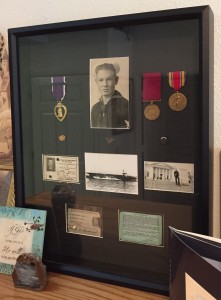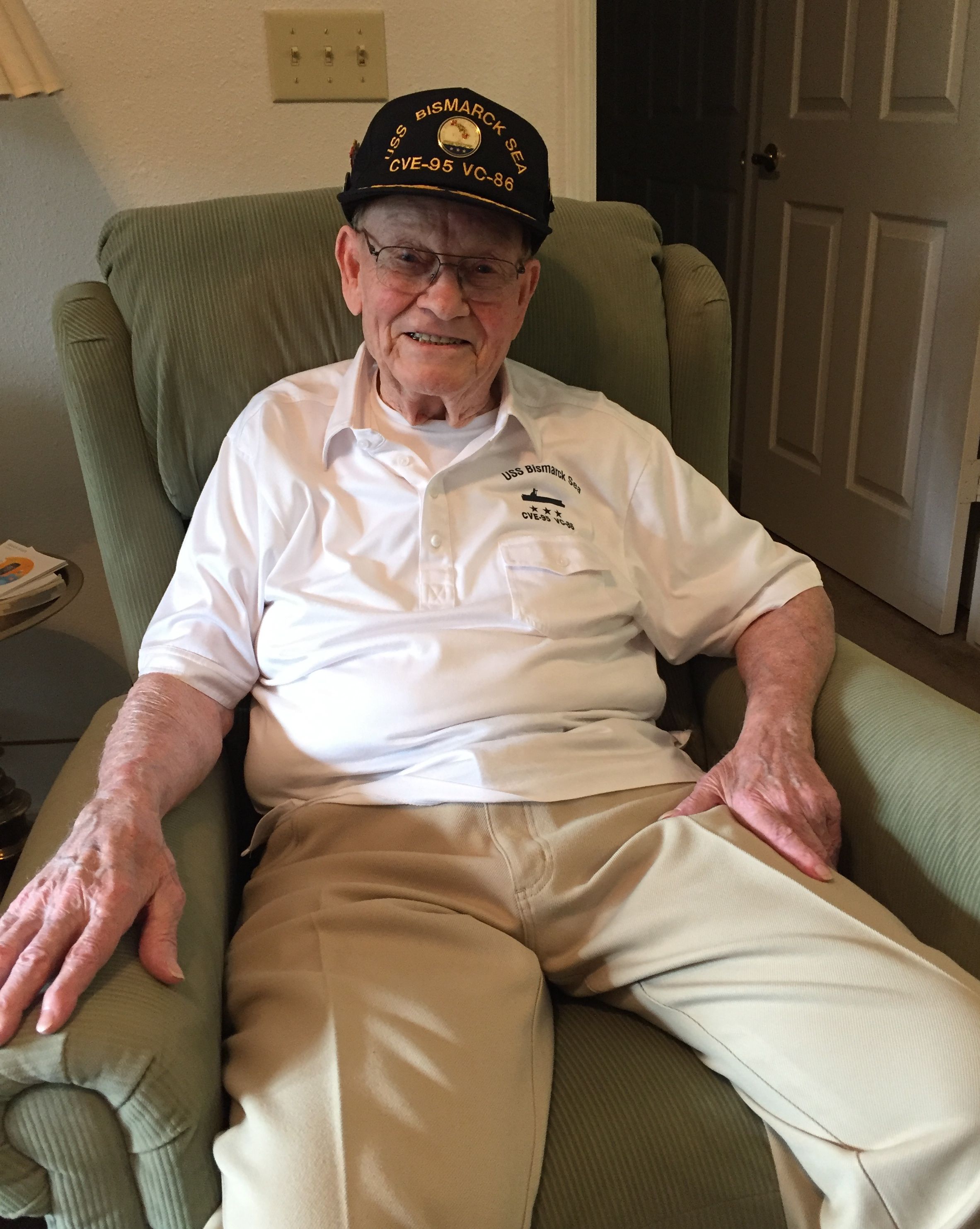Use controls above or click here to open this Hometown Heroes podcast in a new window
90-year-old Albert Henderson of Clovis, CA appears on episode #419 of Hometown Heroes, debuting May 14, 2016. A survivor of the USS Bismarck Sea (CVE-95), the last American carrier to sink in World War II, he’ll explain how he survived, and how he ended up with a unique nickname.

Born in Salt Lake City, Utah, Albert Henderson’s childhood was an uncertain one, as his mother died when he was two years old. For two years, Albert lived with his aunt in Kansas before he moved in with his grandmother in Salt Lake City, and then moved back to California with his father, during a time which he describes as a “whirlwind of hurts, wants and disappointment.” Due to the severity of the Great Depression, the Henderson family had to take advantage of every opportunity to put food on their table by performing odd jobs, selling anything possible, and even moving temporarily to find work elsewhere. Albert’s family’s needs would eventually force him to quit high school so he could work full time.
From a young age, Henderson had always been interested in naval service, and his uncle attempted to convince him to join. On Hometown Heroes, you’ll hear how Albert heard of the Japanese attack at Pearl Harbor. This event influenced Henderson’s life, as his Japanese classmates were all taken away to internment camps. “We hated that because they were all our friends. We grew up with them. We couldn’t figure out why they were doing that,” Henderson remembers. Although Albert wanted to go to school to become a service station operator, his father used his son’s funds to start a business in Phoenix. When Albert went to see his father, he found the building abandoned. Shortly after, he joined the Navy at the age of 17.
From the beginning, Albert knew what he wanted to do in the Navy. “I wanted to be a cook because my father was a cook.” After Henderson attended cooks’ and baker’s school in San Diego, he began work on the USS Bismarck Sea as a second class chef. You’ll hear Henderson speak of the pressure and the difficulties that he encountered as he learned to make food for a large number of people. Albert would prove to be a good steward of the ship’s supply of food, as he made sailors pull out of the ocean the food that they had thrown overboard just because they disliked it. The biggest challenges that Henderson encountered were the time element and the personnel, who were not always willing to work.
Along with cooking meals, Henderson, for a time, was a third loader for one of the guns on the Bismarck Sea whenever general quarters was called. He enjoyed this position because he preferred being topside to remaining in the ship’s galley. This position would not last for him, however, as he was needed in the kitchen more than at the gun, and you’ll hear Henderson explain why this was a good thing in the long run.
The fact that Albert and the men on the ship were in a war first hit him when his ship led an American convoy into the Philippines in the spring of 1944. As they entered the waters around the archipelago, a wave of kamikaze attackers confronted the ships. When a carrier behind the Bismarck Sea was hit, the gravity of the war hit Henderson. “We can get shot.” Henderson realized. February 21, 1945, proved to be a fatal day for the Bismarck Sea, which was sunk off the coast of Iwo Jima. “It was like any other day,” Henderson remembers, as, in the morning, the pilots prepared to fly their missions. When the pilots returned at dusk, there was no time to degas the planes, putting the ship in a precarious position. The Bismarck Sea’s fate was sealed when two kamikaze planes hit the ship, cutting off its water supply and igniting ammunition in the hold. Albert, who was in the kitchen at the time, remembered “a humungous explosion.” With another cook and an injured sailor, Henderson made his way topside, only to discover that the life preservers and rafts had been taken by other members of the crew. When he returned to where he left the two men, he found out that they had left him alone on a burning ship.
As Henderson vividly relates his predicament to the audience, he touches on the beginning of his nickname “The Naked Cook”. For four and a half hours, Albert floated in the choppy Pacific Ocean, praying for God’s help. Although the circumstances made rescue seem nearly impossible, Albert resolved to survive, and “not waste the time” from his swimming coach’s lessons. When Henderson saw the light of a whale motorboat, he took a sign nearby to reflect the light from the motorboat, managing to get the crew’s attention. The boat then took him back to the Patterson, one of the ships assigned to rescue the floating crew members. For his services and injuries, Henderson received the Purple Heart and the Good Conduct Medal.
Recently, Albert has had the honor of taking one of the Honor Flights to Washington D.C. There he saw the memorial to the veterans, and realized that his service is not forgotten. His favorite part of the trip was seeing the memorial to the Marine Corps, a massive statue of the Marines raising the flag on Mount Suribachi at Iwo Jima. “It brings tears to my eyes,” Henderson recalled. Looking back on his life, Albert says, “I was proud. I’ve had a nourishing life, and I’ve appreciated everyone looking out for me and appreciating me.” According to Henderson, the most remarkable part of his story is “that I was stubborn”, never giving up, even when adversity was at its hardest. If you ever encounter this fearless veteran and fully-clothed former cook, be sure to take the time to thank him for serving this great nation.
—summary written by Josiah Weimer

Leave a Reply